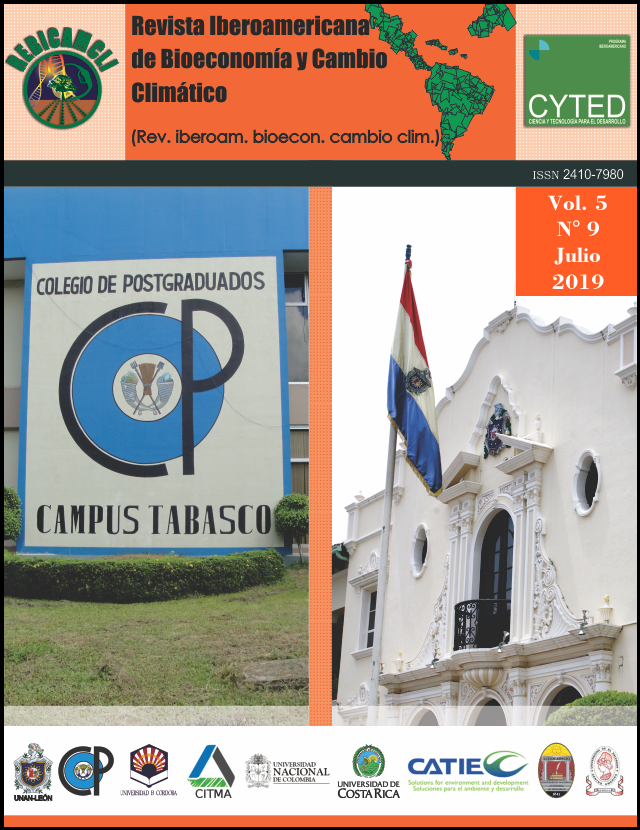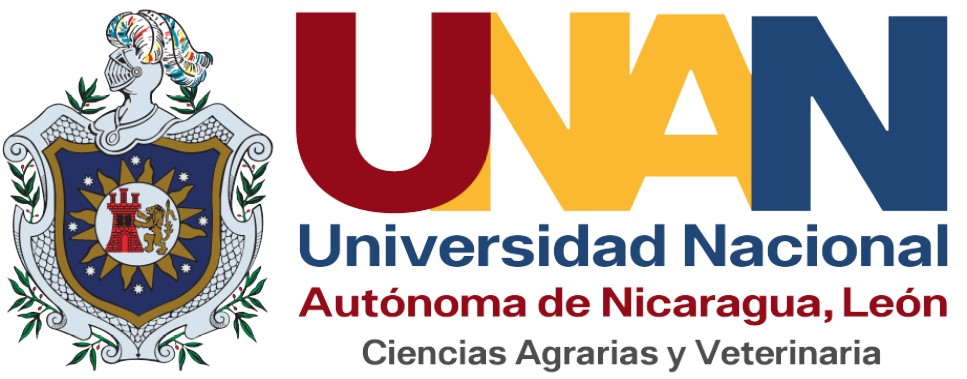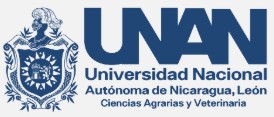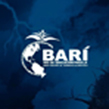Floristic characterization of the species of apicultural use in the volcanic complex "Pilas el Hoyo"
DOI:
https://doi.org/10.5377/ribcc.v5i9.7952Keywords:
Honey species, Apiary, Bignoniáceae; PlantaginaceaAbstract
The study was carried out in the protected area "Volcanic Complex Cerro Negro - Pilas - El Hoyo". The objective of this study was to characterize the honey species in the area. Through this research, beekeepers will have greater knowledge about honey species and their availability during the year. Seven active apiaries distributed between the community of Miramar and the district of Terreros were chosen, where 4 weekly samplings per apiary were carried out using transects of 20m x 50m, taking as starting point the apiaries to identify and count the number of species of beekeeping. The data obtained were exported to Excel. We identified 89 species belonging to 39 families, divided into: 59 tree species, 15 shrub species and 15 herbal species. The families with greater abundance in trees were the Bignoniáceae, Myrtaceae, Fabácea, Ebenaceae and Boraginaceae; in shrubs are Verbenaceae, Boraginaceae, Fabaceae, Apocynaceae and Solanaceae; in herbs are Plantaginacea, Malvaceae, Sterculiaceae, Lamiaceae and Convolvulacea. The use of the land in the apiaries shows 53% of wild forest, 12% of fallow, 8% of peanuts, 12% between corn and sorghum, 9% between eucalyptus, white beans and cassava, 4% between paddocks and cane, 2% between pasture and sesame. There is a greater flowering between the months of December to May. From June to November there is a shortage of flowering, this phenomenon is to compensate with species of prolonged flowering and crops.
Downloads
Metrics
References
Apinet – INTA (Instituto Nacional de Tecnología Agropecuaria, AR). 2000. Cultura apícola (en línea). Buenos Aires, Argentina. Disponible en http://www.culturaapicola.com.ar/apuntes/floraapicola/flora apicola.PDF.
Bazzurro, D. 1999. Flora Apícola (en línea). Disponible en http://www.culturaapicola.com.ar/apuntes/floraapicola/126_FloraApicola.pdf
Carvallo. G,O. 2009. Especies exóticas e invasiones biológicas. (En línea) Ciencia ahora. 12(23): 15-21.
Duttmann, C. Lorenzo, D. Jiménez. M, V. 2013. La Apicultura y Factores que Influyen en Producción, Calidad, Inocuidad y Comercio de la Miel. Investigación Intersectorial de la Sanidad Apícola en el Occidente de Nicaragua. León – Nicaragua. INTA. MAG-FOR. MAPIO
Rosillo H. 2010. Diagnóstico y plan de ordenamiento territorial en el ámbito del proyecto de caficultura sostenible de alto valor para pequeños agricultores pobres, distritos de Alonso de Alvarado roque y san Martín.
Hernández-Salas, Z. T., & Quesada-Monge, R. F. (2000 https://www.ecured.cu/Complejo_Volcánico_[EF9] Pilas_El_Hoyo
Fundación Nicaragüense para el Desarrollo Sostenible (2010). Evaluación y Redefinición del Sistema de Áreas Protegidas Cerro Negro-Pilas-El Hoyo de las Regiones Pacífico y Centro Norte de Nicaragua[EF10] . MARENA-PROTIERRA-CBA. Disponible en: http://www.renida.net.ni/renida/marena/RENP01F981c.pdf
Laboratorio de plantas vasculares, 2006. Inventario Florístico. Argentina. Disponible en: www.plantasvasculares.uns.edu.ar/herbario/galeria/pehuen/index.html
Lúquez, F; y Valle, M. (2008). Caracterización de los Productores Apícolas en siete Comarcas del Municipio del municipio de Camoapa, Boaco, Trabajo de diplomado. Universidad Nacional Agraria, Sede Camoapa (UNA).
Mario R. Quiñónez[EF12] .2012.Programa de Investigación Apícola IPTA-FCA-UNA. Recuperado de http:www.abc.com.py/edicion-impresa/suplementos/abc-rural/floracion-de-especies-vegetales-utiles-a-la-produccion-apícola-389181.html
Meyrat & Alain. 2016. Árboles y arbustos predominantes de Nicaragua. Managua[EF13] .
Paguaga y Soto.2010. Árboles y arbustos de la ciudad de León. Hecho en Costa Rica por la Editorial INBio. Primera edición.[EF14]
Pietronave, H. 2001. El Apicultor, Factores Climáticos que influyen en la apicultura. Disponible en http://www.inta.gov.ar/reconquista/info/documentos/comunicacion/voces_ec os/nro_23_voces_ecos/voces_ecos_23_nota9.pdf
Pymerural. (2012). MAGFOR realiza censo apícola 2012 a nivel del país.
ROJAS M. 2002. Composición y Estructura Horizontal de un Bosque no Intervenido por la Concesión forestal Madensa-Awastigni. Puerto Cabeza. Universidad Nacional Agraria, Nicaragua. Disponible en Internet: www.agris.una.edu.ni/tesis/.
Silva, L.M.; Restrepo, S. 2012. Compendio de calendarios apícolas de Cauca, Huila y Bolívar. Bogotá, Instituto Humboldt. 52 p.
Centeno Keyling y Rodríguez Norma (2016). Tesis. Análisis de la producción de miel de abeja en Nicaragua y principales limitaciones del sector apícola para la exportación a la Unión Europea, I Semestre del 2015. , UNAN-Managua, 2016.
Tercero Martínez. X.L, Sequeira Castillo.C.Y. 2016. Estudio de Pre-Factibilidad para el establecimiento de un apiario, Finca las Delicias, Comunidad el Tule, Municipio San Miguelito, Rio San Juan. Universidad Nacional Agraria, Nicaragua. Managua.
Downloads
Published
How to Cite
License
Copyright (c) 2019 Revista Iberoamericana de Bioeconomía y Cambio Climático

This work is licensed under a Creative Commons Attribution-NonCommercial-ShareAlike 4.0 International License.
Copyright © 2025 Rev. iberoam. bioecon. climate change. National Autonomous University of Nicaragua León (UNAN-León), Knowledge Area of Agrarian and Veterinary Sciences / Specific Area of Agroecology and Agribusiness / Center for Research in Agrarian Sciencies. Academic Directorate. Research Department. Publication and scientific events Unit.












 EDITORIAL
EDITORIAL e-ISSN
e-ISSN


 COPYRIGHT
COPYRIGHT This work is licensed under a Licencia Internacional
This work is licensed under a Licencia Internacional 












